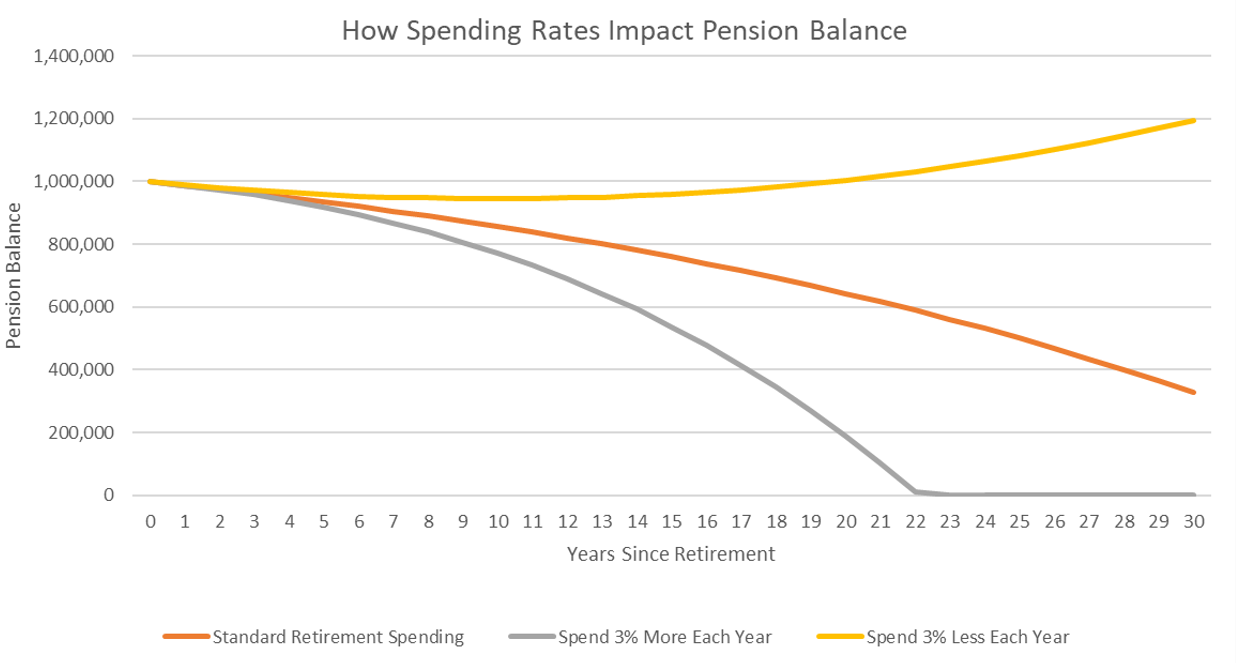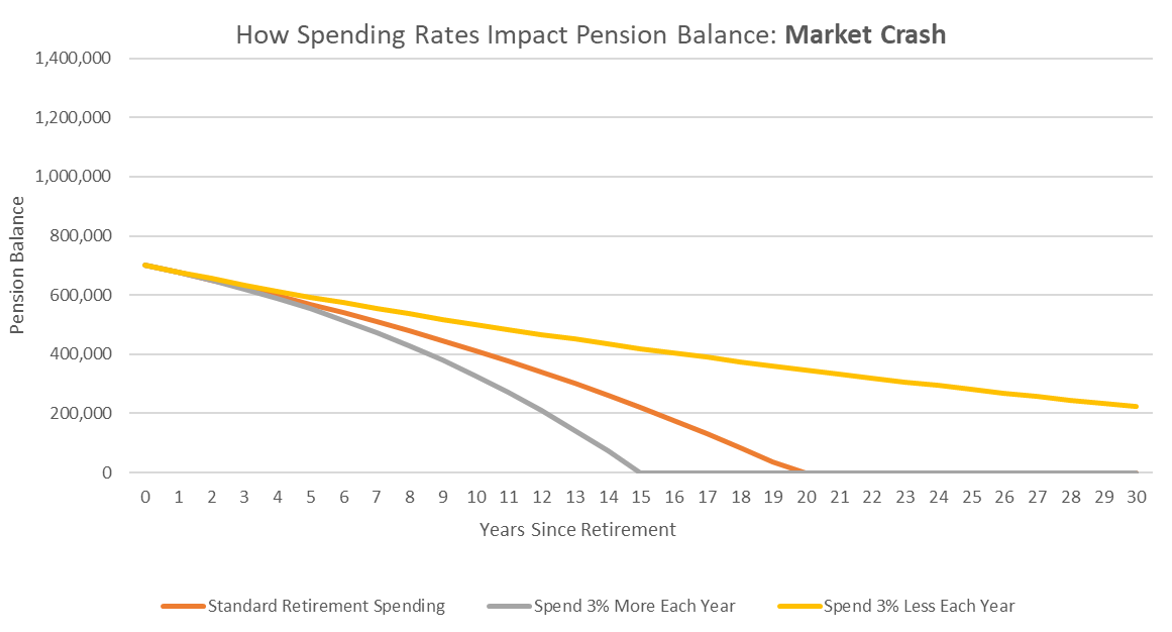The financial services industry may have underestimated the dramatic fall-off in retiree spending as retirees age, according to a Milliman analysis of real-world expenditure data.
This is potentially a positive message for advisers dealing with clients through the COVID-19 crisis.
The median retired couple’s expenditure falls by more than one-third (36.7%) as they move from their peak spending years in early retirement (65 to 69 years of age) and into older age (85 years and beyond). The decline in expenditure for couples is relatively stable in the early years of retirement at about 6% to 8% across each four-year age band, but then rapidly accelerates once retirees pass 80 years of age.
Association of Superannuation Funds of Australia (ASFA) has previously estimated a “comfortable” couple aged 85+ years will spend about 7.8% less than those aged 65-85 years of age. Another industry study by the Australian Institute of Superannuation Trustees (AIST), based on Household, Income and Labour Dynamics in Australia (HILDA) data, has suggested that spending may not decline materially through retirement.
However, the Milliman Retirement Expectations and Spending Profiles (ESP) analysis is the first based on the actual spending of more than 300,000 Australian retirees.
The data shows that retirees’ food expenditure – the largest component of essential spending – declines steeply with age, while health spending increases with age but dips again after age 80. All discretionary expenditure, such as travel and leisure, declines throughout retirement.
The faster-than-expected drop-off in spending casts doubt on some common rules of thumb and suggests that financial plans for retirees that assume a steady or increasing spending over time may be conservative relative to actual behaviour. This is potentially good news for advisers and their clients given recent events.
If we compare a small increase of 3% each year in a $50,000 p.a. retirement spend with an equivalent decrease of 3%, we find that this change has massive implications on retirement account balances (Figure 1). In fact, in the scenario where spending decreases annually, retirees can end up with a higher account balance than when they first retired, due to underlying asset growth outstripping spending. Even assuming no annual increase in spending results in a drastically different picture that can help to offset the concern of seeing a drop in asset values as a result of market volatility.
Figure 1: How spending rates impact pension balance

Additionally, this drop off in spending can help soften the impact of a market crash shortly before retirement (Figure 2). If we consider a 30% drop in asset values, but still take the same annual withdrawal amounts as before, decreasing spending throughout retirement mitigates longevity risk and helps reduce the chances of funds running out.
Figure 2: How spending rates impact pension balance in a market crash scenario

Financial advisers are well positioned to coach clients that may have recently entered or are considering retirement. Their experiences with other clients who have successfully navigated retirement for many years are real-life examples of the lifestyle changes and reduced spending behaviour that evolves naturally.
In addition, clients of financial advisers will be better placed to amend their short-term behaviour and, combined with changes to minimum withdrawal rates, will be more resilient in the face of ongoing volatility. This may mean dialling back areas of discretionary expenditure in order to focus on the essential costs of daily living.
Incorporation of conservatism within the planning process, whether captured in client goals, the use of bucket strategies or implementation of portfolio risk management approaches can be a boon in times such as these.
Milliman is a retirement and risk specialist that provides investment advisory, hedging and consulting services to more than $240 billion of global assets. It recently launched the Milliman SmartShield range of Managed Accounts’, designed to provide direct protection against market downturns.
For more information go to: https://advice.milliman.com/en/smartshield.
Key assumptions and methodology
A 30 year timeline has been used, with an initial withdrawal of $50,000 p.a. A flat withdrawal amount is compared with an amount increasing by 3% annually and one decreasing by 3% annually.
A starting account balance of $1,000,000 has been assumed along with a rate of 4% growth p.a. on this balance, post withdrawal each period.
In the market crash scenario the starting account balance was decreased to $700,000 to simulate an instantaneous 30% drop in asset values.
Disclaimers
This document has been prepared by Milliman Pty Ltd ABN 51 093 828 418 AFSL 340679 (Milliman AU) for provision to Australian financial services (AFS) licensees and their representatives, and for other persons who are wholesale clients under section 761G of the Corporations Act.
To the extent that this document may contain financial product advice, it is general advice only as it does not take into account the objectives, financial situation or needs of any particular person. Further, any such general advice does not relate to any particular financial product and is not intended to influence any person in making a decision in relation to a particular financial product. No remuneration (including a commission) or other benefit is received by Milliman AU or its associates in relation to any advice in this document apart from that which it would receive without giving such advice. No recommendation, opinion, offer, solicitation or advertisement to buy or sell any financial products or acquire any services of the type referred to or to adopt any particular investment strategy is made in this document to any person.
The information in relation to the types of financial products or services referred to in this document reflects the opinions of Milliman AU at the time the information is prepared and may not be representative of the views of Milliman, Inc., Milliman Financial Risk Management LLC, or any other company in the Milliman group (Milliman group). If AFS licensees or their representatives give any advice to their clients based on the information in this document they must take full responsibility for that advice having satisfied themselves as to the accuracy of the information and opinions expressed and must not expressly or impliedly attribute the advice or any part of it to Milliman AU or any other company in the Milliman group. Further, any person making an investment decision taking into account the information in this document must satisfy themselves as to the accuracy of the information and opinions expressed. Many of the types of products and services described or referred to in this document involve significant risks and may not be suitable for all investors. No advice in relation to products or services of the type referred to should be given or any decision made or transaction entered into based on the information in this document. Any disclosure document for particular financial products should be obtained from the provider of those products and read and all relevant risks must be fully understood and an independent determination made, after obtaining any required professional advice, that such financial products, services or transactions are appropriate having regard to the investor's objectives, financial situation or needs.
All investment involves risks. Any discussion of risks contained in this document with respect to any type of product or service should not be considered to be a disclosure of all risks or a complete discussion of the risks involved. Investing in foreign securities is subject to greater risks including: currency fluctuation, economic conditions, and different governmental and accounting standards. There are also risks associated with futures contracts. Futures contract positions may not provide an effective hedge because changes in futures contract prices may not track those of the securities they are intended to hedge. Futures create leverage, which can magnify the potential for gain or loss and, therefore, amplify the effects of market, which can significantly impact performance. There are also risks associated with investing in fixed income securities, including interest rate risk, and credit risk.
An investment in an underlying portfolio, whether with or without Milliman Managed Risk Strategy (MMRS) is subject to market and other risks and no guarantee or assurance is given by Milliman AU or any company in the Milliman group that the use of MMRS in connection with an underlying portfolio will not give rise to losses or that the performance of the MMRS in relation to the underlying portfolio will remove volatility completely or to the extent depicted in an illustration or fully replace losses in the underlying portfolio or to the extent depicted. While generally assets used in connection with the MMRS are liquid, this may not be the case in all circumstances. Further, during periods of sustained market growth, the return to clients from the combination of an underlying portfolio and MMRS should be less than if a client had no MMRS.
Any source material included in this document has been sourced from providers that Milliman AU believe to be reliable from information available publicly or with consent of the provider of the source material. To the fullest extent permitted by law, no representation or warranty, express or implied is made by any company in the Milliman group as to the accuracy or completeness of the source material or any other information in this document.
Past performance information provided in this document is not indicative of future results and the illustrations are not intended to project or predict future investment returns.
Any index performance information is for illustrative purposes only, does not represent the performance of any actual investment or portfolio. It is not possible to invest directly in an index.
Any hypothetical, back tested data illustrated herein is for illustrative purposes only, and is not representative of any investment or product.
Results based on simulated or hypothetical performance results have certain inherent limitations. Unlike the results shown in an actual performance record, these results do not represent actual trading. Also, because these trades have not actually been executed, these results may have under-or over-compensated for the impact, if any, of certain market factors such as lack of liquidity. Simulated or hypothetical trading programs in general are also subject to the fact that they are designed with the benefit of hindsight. No representation is being made that any account will or is likely to achieve profits or losses similar to these being shown.
For any hypothetical simulations illustrated, Milliman AU does not manage, control or influence the investment decisions in the underlying portfolio. The underlying portfolio in hypothetical simulations use historically reported returns of widely known indices. In certain cases where live index history is unavailable, the index methodology provided by the index may be used to extend return history. To the extent the index providers have included fees and expenses in their returns, this information will be reflected in the hypothetical performance.